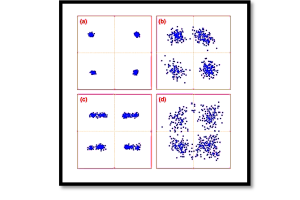
Understanding PLL Transient Behavior
Introduction
Phase-Locked Loops (PLLs) are essential in various electronic applications, particularly in communications, where they are used for clock generation, frequency synthesis, and phase synchronization. One critical aspect of PLL performance is its transient behavior, which refers to how the PLL responds over time as it transitions from an unlocked state to a locked state. Understanding and analyzing this transient behavior is crucial for designing PLLs that are stable, fast, and reliable.
What is PLL Transient Behavior?
Transient behavior in PLLs encompasses the dynamic processes and responses that occur when the system is in the process of acquiring lock to a reference signal. This involves several stages:
- Acquisition: The initial stage where the PLL begins to adjust its output frequency and phase to match the reference signal.
- Lock-in: The period during which the PLL reduces the phase error and converges to a stable state where the output frequency matches the reference frequency.
- Settling: The final phase where the PLL fine-tunes its output to minimize any residual phase error or jitter.
The key parameters to consider in transient behavior analysis include lock time, overshoot, settling time, and phase noise.
Key Parameters of PLL Transient Behavior
- Lock Time: Lock time is the duration it takes for the PLL to synchronize with the reference signal. It is a critical parameter for applications requiring quick frequency acquisition, such as in fast-switching communication systems.
- Overshoot: Overshoot occurs when the PLL output temporarily exceeds the desired frequency before settling. This can lead to temporary instability and is often minimized through careful design of the loop filter.
- Settling Time: Settling time is the period needed for the PLL output to stabilize within a specified tolerance band around the desired frequency. It directly impacts the overall response time of the system.
- Phase Noise: Phase noise describes the short-term frequency fluctuations in the PLL output and is crucial for applications requiring high precision and stability.
Factors Influencing PLL Transient Behavior
Several factors affect the transient behavior of PLLs, including:
- Loop Filter Design: The loop filter determines the dynamics of the PLL, affecting how quickly and smoothly the PLL can acquire lock. The filter design involves selecting appropriate resistor, capacitor, and inductor values to balance the trade-offs between lock time, stability, and phase noise.
- VCO Characteristics: The Voltage-Controlled Oscillator (VCO) plays a vital role in determining the frequency range and responsiveness of the PLL. A high-quality VCO with low phase noise and a wide tuning range contributes to better transient performance.
- Phase Detector Type: The choice of phase detector, whether it’s a simple XOR gate, a phase-frequency detector (PFD), or a more sophisticated architecture, influences the accuracy and speed of phase error detection and correction.
- Reference Signal Quality: The quality of the reference signal, including its stability and noise characteristics, directly impacts the PLL’s ability to achieve and maintain lock.
Analyzing PLL Transient Behavior
Analyzing the transient behavior of a PLL involves both time-domain and frequency-domain techniques:
- Time-Domain Analysis:
- Phase Error Plot: A plot of the phase error over time helps visualize how quickly and effectively the PLL reduces the phase difference.
- Frequency and Phase Response: Monitoring the PLL output frequency and phase provides insight into the dynamics of the lock-in process.
- Frequency-Domain Analysis:
- Spectral Analysis: Performing an FFT on the output signal can reveal the presence of spurious tones and phase noise components.
- Phase Noise Measurement: Quantifying the phase noise across different offset frequencies provides a detailed understanding of the PLL’s short-term stability.
Practical Considerations and Optimization
Optimizing the transient behavior of a PLL requires careful consideration of design trade-offs and practical constraints:
- Simulation and Modeling: Tools like Keysight ADS, MATLAB, and SPICE-based simulators allow designers to model and simulate PLL behavior under various conditions, helping to predict and optimize transient performance before physical implementation.
- Component Selection: High-quality components with low tolerances and minimal parasitics should be selected to ensure predictable and stable PLL operation.
- Prototyping and Testing: Building prototypes and conducting extensive testing under real-world conditions is essential to validate simulation results and fine-tune the PLL design.
Take our entry level course (Below) for free using coupon code RAHRF101BLOG
RF Fundamentals, Basic Concepts and Components – RAHRF101
For limited time take an additional 10% off of all our courses using coupon code RFCERT10
Rahsoft RF Certificate and courses
Conclusion
PLL transient behavior is a complex but crucial aspect of PLL design that directly impacts the performance and reliability of electronic systems. By understanding the key parameters, influencing factors, and analysis techniques, engineers can design PLLs that meet stringent performance requirements. Through careful optimization and rigorous testing, PLLs can achieve fast lock times, minimal overshoot, and low phase noise, ensuring their effective operation in a wide range of applications.
Understanding and mastering PLL transient behavior is essential for developing advanced communication systems, high-precision instrumentation, and other critical electronic applications. With the right tools and techniques, engineers can push the boundaries of PLL performance, enabling the next generation of electronic innovations.

Learn more about this topic by taking the complete course ‘Phase Lock Loop System Design Theory and Principles RAHRF469’. Watch the course videos for more detailed understanding. Also checkout other courses on RF system and IC design on https://rahsoft.com/courses/. Rahsoft also provides a certificate on Radio Frequency. All the courses offer step by step approach.



